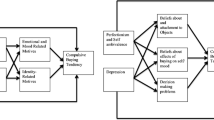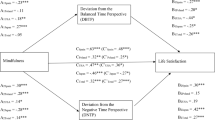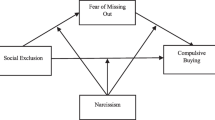Abstract
Compulsive buying is an intensively studied phenomenon with different potential causes having been identified: materialistic values, personality deficiencies, factors of socialization, and the role of consumption culture. However, we challenge that these are the appropriate mechanisms for the underlying the responsible factors. Any new efficient approaches for therapeutic remedies will depend on identifying the most powerful psychological causes of compulsive buying. In the current study, time perspectives, measured by Zimbardo Time Perspective Inventory—ZTPI (Zimbardo and Boyd 1999)—are tested to ascertain if they could be identified as essential factors of influence on buying behavior. It was hypothesized that a high Past-Negative, a high Present-Fatalistic, and a high Present Hedonistic Perspective will foster compulsive buying tendencies, measured by the German Compulsive Buying Scale (Raab et al. 2005), whereas a high Future and a high Past-Positive Perspective will inhibit such compulsive buying. The hypotheses were confirmed throughout three cultural settings (German, Ukrainian and a Chinese student-sample) for Past-Negative, Present-Fatalistic, and Present-Hedonistic. Some inconsistencies were found for Past Positive and Future. Mediation analysis revealed that deviation from a balanced time perspective (DBTP) mediates partly or completely the influence of the factor “country” on proneness for compulsive buying tendencies in two out of three cross-cultural comparisons. Binary logistical regressions further identified DBTP as the essential factor in explaining the differences between the three countries in percentages of those being identified at high risk for compulsive buying.



Similar content being viewed by others
References
Achtziger, A., Hubert, M., Kenning, P., Raab, G., & Reisch, L. (2015). Debt out of control: the links between self-control, compulsive buying, and real debts. Journal of Economic Psychology, 49, 141–149. https://doi.org/10.1016/j.joep.2015.04.003.
Andreassen, C.S., Griffiths, M.D., Pallesen, S., Bilder, R.M., Torsheim, T., & Aboujaoude, E. (2015). The Bergen Shopping Addiction Scale: reliability and validity of a brief screening test. Frontiers in Psychology, 6(1374). doi: https://doi.org/10.3389/fpsyg.2015.01374. eCollection 2015.
Bandura, A. (2012). On the functional properties of perceived self-efficacy revisited. Journal of Management, 38(1), 9–44. https://doi.org/10.1177/0149206311410606.
Bani-Rshaid, A. M., & Alghraibehb, A. M. (2017). Relationship between compulsive buying and depressive symptoms among males and females. Journal of Obsessive-Compulsive and Related Disorders, 14, 47–50. https://doi.org/10.1016/j.jocrd.2017.05.004.
Benson, A. L., Eisenach, D., Abrams, L., & van Stolk-Cooke, K. (2014). Stopping overshopping: a preliminary randomized controlled trial of group therapy for compulsive buying disorder. Journal of Groups in Addiction & Recovery, 9(2), 97–125. https://doi.org/10.1080/1556035X.2014.868725.
Boniwell, I., & Zimbardo, P.G. (2004). Balancing time perspective in pursuit of optimal functioning. In P. Alex Linley, & S. Joseph (Eds.), Positive psychology in practice. New Jersey: John Wiley & Sons.
Carmines, E., & McIver, J. (1981). Analyzing models with unobserved models: analysis of covariance structures (pp. 165–178). Beverly Hills: Sage Hoboken: John Wiley & Sons.
Claes, L., & Müller. (2017). Resisting temptation: is compulsive buying an expression of personality deficits? Current Addiction Reports, 4(3), 237–245. https://doi.org/10.1007/s4042.
Dittmar, H. (2005). A new look at ‘compulsive buying’: self-discrepancies and materialistic values as predictors of compulsive buying tendency. Journal of Social and Clinical Psychology, 24(6), 832–859. https://doi.org/10.1521/jscp.2005.24.6.832.
Donnelly, G. E., Ksendzova, M., Howell, R. T., Vohs, K. D., & Baumeister, R. F. (2016). Buying to blunt negative feelings: materialistic escape from the self. Review of General Psychology, 20(3), 272–316. https://doi.org/10.1037/gpr0000078.
Epel, E. S., Bandura, A., & Zimbardo, P. G. (1999). Escaping homelessness: the influences of self-efficacy and time perspective on coping with homelessness. Journal of Applied Social Psychology, 29(3), 575–596. https://doi.org/10.1111/j.1559-1816.1999.tb01402.x.
Faber, R. J., & Christenson, G. A. (1996). In the mood to buy: differences in the mood states experienced by compulsive buyers and other consumers. Psychology and Marketing, 13(8), 803–819. https://doi.org/10.1002/(SICI)1520-6793(199612)13:8<803.
Faber, R. J., & Vohs, K. D. (2011). Self-regulation and spending—evidence from impulsive and compulsive buying. In K. D. Vohs & R. F. Baumeister (Eds.), Handbook of self-regulation: research, theory and applications (pp. 537–550). New York: Guilford Press.
Fieulaine, N., & Martinez, F. (2011). Time under control: time perspective and desire for control in substance use, Addictive Behaviors., 35(8), 799–802. https://doi.org/10.1016/j.addbeh.2010.03.022.
Friese, S. (2001). Explaining the gap between compulsive and non-compulsive buyers regarding their actual/ideal self-discrepancies: how different, actually, are their ideal images? Academy of Marketing Studies Journal, 5(1), 113–141.
Goldsmith, R. E., Flynn, & Goldsmith, E. B. (2015). Consumer characteristics associated with compulsive buying. Journal of Multidisciplinary Research, 7(3), 21–38.
Granero, R., Fernández-Aranda, F., Baño, M., Steward, T., Mestre-Bach, G., del Pino-Gutiérrez, A., Moragas, L., Mallorquí-Bagué, N., Aymamí, N., Goméz-Peña, M., Tárrega, S., Menchón, J. M., & Jiménez-Murcia, S. (2016). Compulsive buying disorder clustering based on sex, age, onset and personality traits. Comprehensive Psychiatry, 68, 1–10. https://doi.org/10.1016/j.comppsych.2016.03.003.
Griffiths, M. D., Andreassen, C. S., Pallesen, S., Bilder, R. B., Torsheim, T., & Aboujaoude, E. (2016). When is a new scale not a new scale? The case of the Bergen Shopping Addiction Scale and the Compulsive Online Shopping Scale. International Journal of Mental Health and Addiction, 14(6), 1107–1110. https://doi.org/10.1007/s11469-016-9711-1.
Grougiou, V., Moschis, G., Robinson, J. M., & Kapoutsis, I. (2015). Compulsive buying: the role of earlier-in-life events and experiences. Journal of Consumer Marketing, 32(4), 278–289. https://doi.org/10.1108/JCM-01-2015-1283.
Harnish, R. J., Bridges, K. R., & Karelitz, J. L. (2017). Compulsive buying: prevalence, irrational beliefs and purchasing. International Journal of Mental Health and Addiction, 15(5), 993–1007. https://doi.org/10.1007/s11469-016-9690-2.
Hoch, S. J., & Loewenstein, G. F. (1991). Time-inconsistent preferences and consumer self-control, Journal of Consumer Research., 17(4), 492–507. https://doi.org/10.1086/208573.
Horváth, C., & Adıgüzel, F. (2018). Shopping enjoyment to the extreme: Hedonic shopping motivations and compulsive buying in developed and emerging markets. Journal of Business Research, 86, 300–310. https://doi.org/10.1016/j.jbusres.2017.07.013.
Jiang, Z., Zhao, X., & Li, C. (2017). Self-control predicts attentional bias assessed by online shopping-related Stroop in high online shopping addiction tendency college students. Comprehensive Psychiatry, 75, 14–21. https://doi.org/10.1016/j.comppsych.2017.02.007.
Ku, L., Wu, A. M. S., Lao, A. K. P., & Lam, K. I. N. (2016). “We want the world and we want it now”: materialism, time perspectives and problem spending tendency of Chinese, International Journal of Psychology., 4(3), 166–175. https://doi.org/10.1002/ijop.12391.
Lejoyeux, M., & Weinstein, A. (2010). Compulsive buying. American Journal of Drug an Alcohol Abuse, 36(5), 248–253. https://doi.org/10.3109/00952990.2010.493590.
Lewin, K. (1942). Time perspective and morale. In G. Watson (Ed.), Civilian morale: second yearbook of the Society for the Psychological Study of Social Issues (pp. 48–70). Boston: Houghton Mifflin Company.
Lewin, K. (1951). Field theory in social science: selected theoretical papers. New York: Harper.
Li, S., Unger, A., & Bi, C. (2014). Different facets of compulsive buying among Chinese students. Journal of Behavioral Addictions, 3, 238–245. https://doi.org/10.1556/JBA.3.2014.4.5.
MacCallum, R. C., Browne, M. W., & Sugawara, H. M. (1996). Power analysis and determination of sample size for covariance structure modeling. Psychological Methods, 1(2), 130–149.
Manchiraju, S., Sadachar, A., & Ridgway, J. L. (2017). The compulsive online shopping scale (COSS): development and validation using panel data. International Journal of Mental Health and Addiction, 15(1), 209–223. https://doi.org/10.1007/s11469-016-9662-6.
Maraz, A., Eisinger, A., Hende, Urbán, R., Paksi, B., Kun, B., Kökönyei, G., Griffiths, M. D., & Demetrovics, Z. (2015). Measuring compulsive buying behaviour: psychometric validity of three different scales and prevalence in the general population and in shopping centres. Psychiatry Research, 225(3), 326–334. https://doi.org/10.1016/j.psychres.2014.11.080.
Maraz, A., Griffiths, M. D., & Demetrovics, Z. (2016). The prevalence of compulsive buying in non-clinical populations: a systematic review and meta-analysis. Addiction, 111, 408–419. https://doi.org/10.1111/add.13223.
Moulding, R., Duong, A., Nedeljkovic, M., & Kyrios, M. (2017). Do you think that money can buy happiness? A review of the role of mood, materialism, self, and cognitions in compulsive buying. Current Addiction Reports, 4(3), 254–261. https://doi.org/10.1007/s40429-017-0154-y.
Müller, A., Mitchell, J. E., & de Zwaan, M. (2015). Compulsive buying. The American Journal on Addictions, 24(2), 132–137. https://doi.org/10.1111/ajad.12111.
Neuner, M., Raab, G., & Reisch, L. A. (2005a). Compulsive buying as a consumer policy issue in East and West Germany. In K. G. Grunert & J. Thøgersen (Eds.), Consumers, policy and the environment. A tribute to Folke Ölander (pp. 89–114). New York: Springer.
Neuner, M., Raab, G., & Reisch, L. A. (2005b). Compulsive buying in maturing consumer societies: an empirical re-inquiry. Journal of Economic Psychology, 26(4), 509–522. https://doi.org/10.1016/j.joep.2004.08.002.
Otero-López, J. M., & Villardefrancos, E. (2014). Prevalence, socio demographic factors, psychological distress, and coping strategies related to compulsive buying: a cross sectional study in Galicia, Spain. BMC Psychiatry, 14(101). https://doi.org/10.1186/1471-244X-14-101.
Oyserman, D., Coon, H. M., & Kemmelmeier, M. (2002). Rethinking individualism and collectivism: evaluation of theoretical assumptions and meta-analyses. Psychological Bulletin, 128(1), 3–72. https://doi.org/10.1037//0033-2909.128.1.3.
Pham, T. H., Yap, K., & Dowling, N. A. (2012). The impact of financial management practices and financial attitudes on the relationship between materialism and compulsive buying. Journal of Economic Psychology, 33, 461–470. https://doi.org/10.1016/j.joep.2011.12.007.
Raab, G., Neuner, M., Reisch, L. A., & Scherhorn, G. (2005). SKSK Screeningverfahren zur Erhebung von kompensatorischem und süchtigem Kaufverhalten[Screening procedure for the measurement of compensatory and compulsive buying behavior]. Göttingen: Hogrefe.
Reuschenbach, B., Funke, J., Drevensek, A., & Ziegler, N. (2013). Testing a German version of the Zimbardo Time Perspective Inventory (ZTPI). Annales Universitatis Paedagogicae Cracoviensis Studia Psychologica, 6, 16–28.
Ridgway, N. M., Kukar-Kinney, M., & Monroe, K. B. (2008). An expanded conceptualization and a new measure of compulsive buying. Journal of Consumer Research, 35(4), 622–639. https://doi.org/10.1086/591108.
Roberts, J. A., Manolis, C., & Pullig, C. (2014). Contingent self-esteem, self-presentational concerns, and compulsive buying. Psychology and Marketing, 31(2), 147–160. https://doi.org/10.1002/mar.20683.
Roberts, J. A., Yaya, L. H. P., & Gwin, C. (2015). Yielding to temptation in buying: Is it simply a matter of self-control? Atlantic Marketing Journal, 4(2), 73–107.
Rotter, J. B. (1990). Internal versus external control of reinforcement: a case history of a variable. American Psychologist, 45(4), 489–493. https://doi.org/10.1037//0003-066X.45.4.489.
Scherhorn, G., Reisch, L. A., & Raab, G. (1990). Addictive buying in West Germany: an empirical study. Journal of Consumer Policy, 13(4), 355–387. https://doi.org/10.1007/BF00412336.
Sircova, A., Sokolova, E. T., & Mitina, O. V. (2008). Адаптация опросника по временной перспективе Ф. Зимбардо на русскоязычной выборке [Adaptation of Zimbardo Time Perspective Inventory]. Psikhologigesky Journal, 29(3), 101–109.
Sircova, A., van de Vijver, F. J. R., Osin, E., Milfont, T. L., Fieulaine, N., Kislali-Erginbilgic, A., et al. (2014). A global look at time. A 24-country study of the equivalence of the Zimbardo Time Perspective Inventory. Sage Open, 4(1), 1–12. https://doi.org/10.1177/2158244013515686.
Stolarski, M., Bitner, J., & Zimbardo, P. G. (2011). Time perspective, emotional intelligence and discounting of delayed awards. Time & Society, 20(3), 246–363. https://doi.org/10.1177/0961463X11414296.
Valence, G., d’Astous, A., & Fortier, L. (1988). Compulsive buying: concept and measurement. Journal of Consumer Policy, 11(4), 419–433. https://doi.org/10.1007/BF00411854.
Van Beek, W., Berghuis, H., Kerkhof, A., & Beekman, A. (2011). Time perspective, personality and psychopathology: Zimbardo’s time perspective inventory in psychiatry. Time & Society, 20(3), 364–374. https://doi.org/10.1177/0961463X10373960.
Vohs, K. D., & Faber, R. J. (2007). Spent resources: Self-regulatory resource availability affects impulse buying. Journal of Consumer Research, 33(4), 537–547. https://doi.org/10.1086/510228.
Weinstein, A., Mezig, H., Mizrachi, S., & Lejoyeux, M. (2015). A study investigating the association between compulsive buying with measures of anxiety and obsessive-compulsive behavior among internet shoppers. Journal of Comprehensive Psychiatry, 57, 46–50. https://doi.org/10.1016/j.comppsych.2014.11.003.
Weinstein, A., Maraz, A., Griffiths, M. D., Lejoyeux, M., & Demetrovics, Z. (2016). Compulsive buying—features and characteristics of addiction. In V. Preedy (Ed.), Neuropathology of drug addictions and substance misuse—Volume 3 (pp. 99–1007). London: Academic Press. https://doi.org/10.1016/B978-0-12-800634-4.00098-6.
Wills, T. A., Sandy, J. M., & Yaeger, A. M. (2001). Time perspective and early-onset substance use: a model based on stress-coping theory. Psychology of Addictive Behaviors, 15(2), 118–125. https://doi.org/10.1037/0893-164X.15.2.118.
Zhao, H., Wei Tian, W., & Xin, T. (2017). The development and validation of the online shopping addiction scale. Frontiers in Psychology, 8(735). https://doi.org/10.3389/fpsyg.2017.00735.
Zimbardo, P. G., & Boyd, J. N. (1999). Putting time in perspective: a valid, reliable individual-differences metric. Journal of Personality and Social Psychology, 77(6), 1271–1288. https://doi.org/10.1037/0022-3514.77.6.1271.
Zimbardo, P. G., Sword, R. M., & Sword, R. K. M. (2012). The time cure: overcoming PTSD with the new psychology of time perspective therapy. New York: Jossey-Bass.
Acknowledgements
We would like to thank Ganna Gardener, Nataliya Rappich, and Ganna Ichenska for their invaluable support in data collection in Ukraine and Qizhou Lu (University of Fuzhou, China) for enabling data collection in China. We are further very thankful for the invaluable advice for aspects of measurement given by Anna Sircova (DIS, Copenhagen, Denmark) and Oksana Senyk (Lviv University, Ukraine).
Author information
Authors and Affiliations
Corresponding author
Ethics declarations
Conflict of Interest
The authors declare that they have no conflict of interest.
Ethics
All of the involved research institutions approved the research design and approved it to be in accordance with their ethical standards. All participants were informed about the study and all provided informed consent.
Rights and permissions
About this article
Cite this article
Unger, A., Lyu, H. & Zimbardo, P.G. How Compulsive Buying Is Influenced by Time Perspective—Cross-Cultural Evidence from Germany, Ukraine, and China. Int J Ment Health Addiction 16, 525–544 (2018). https://doi.org/10.1007/s11469-018-9942-4
Published:
Issue Date:
DOI: https://doi.org/10.1007/s11469-018-9942-4




